How has MIPS performed YTD in 2015 ?
2015 has been one of the toughest markets for timing models, mainly because of its volatility. It does not matter to mathematical models why the market is volatile (the Fed, Greece, China, etc.).
It is difficult for timing models to make money when the indices stay flat (plus or minus 2.5% around mean line), but change direction every 3-6 days (flat market in a very tight trading range). Most models will get whipsawed if they try to trade in a market like this (e.g., trying to trade every time the market "changes direction").
In the graph below, it can be seen that the 2015 market (aka the SPY) changed direction 28 times before it broke the flat trading pattern to the downside (starting on 8/19/15). That is a directional change (short-term trend change) every 4-6 days. Most timing models that tried to trade these "swings" got cremated. Through the end of July 2015, the MIPS models traded only 3-4 times, and was slightly ahead of its index (the SPY) at that time. And, all MIPS models issued a CASH signal on 8/18/15, the day that the "big drop" started !
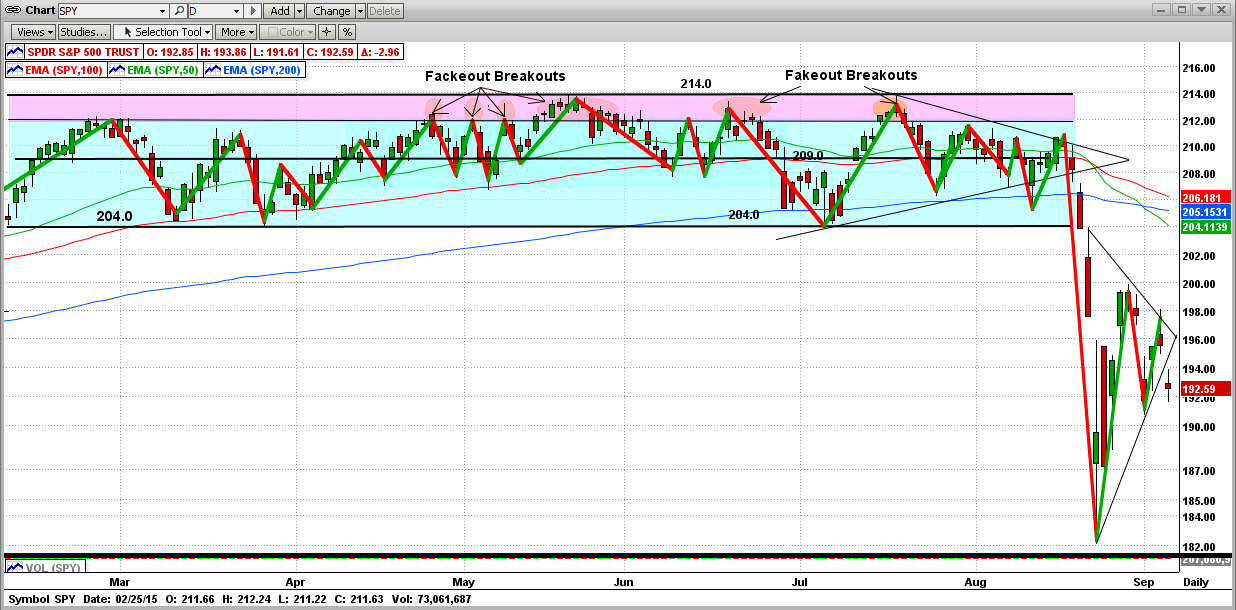
MIPS in August 2015
ONE BAD DAY
So far, so good. MIPS issued a Cash signal on 8/18/15. On that day, the SPY closed at 210.0 and it opened the next morning (8/19/15) at 209.1. By issuing a Cash signal on 8/18/15, MIPS avoided a lot of "damage" until 8/21/15 came along. On 8/20/15, the SPY closed at 204.0 while MIPS was still in Cash, so up until that time we had avoided a drop of about 2.4%.
But then, starting on 8/21/15, all hell broke loose. In two trading days (Friday and Monday), the market experienced extreme volatility and dropped dramatically. On Monday of 8/24/15, the SPY hit an intraday low of 182.4, a drop of 10.6% in two trading days from the 8/20/15 close. That extremely large two-day drop resulted mainly from the one-day drop of 15.2 points in the SPY from the close on 8/21/15 (Friday) to the intraday low on 8/24/15 (Monday). This is roughly equivalent to about 150 points in the S&P 500 Index, and a near 1200 point drop in the Dow). This day was one of the largest one-day drops in the history of the US stock markets. Wow, that really was ONE BAD DAY !!!
MIPS issued a short signal on 8/21/15, which of course was executed on the open of 8/24/15 at 187.5. This was near the low and when the SPY was ready to "rebound" from the dramatic drop. After MIPS issued a cash signal on 8/27/15 (three trading days later), this one trade had lost about 6%. In effect, we "shorted" very near the bottom - ONE BAD TRADE !!!
For a model like MIPS4 that compounds with a CAGR of approximately 25-30%, this is like a "blip", so don't worry (see the MIPS4 growth graph at the bottom of this blog).
Please remember, whether a timing model did well on this one-day drop or not is basically pure luck. One bad day can happen at any time, and no timing model can consistently predict any one day's price action to the day. In this case, it stands out because the one-day change was so dramatic. This one-bad-day was going to happen whether MIPS (or any other model) was long, short, or cash. Good timing models recover, like MIPS did in 2011 and should do again in 2015. After a flat 2011, MIPS3 was up 9% in 2012 and 23.3% in 2013.
MIPS4 in August 2015
(Red dots are Trades dates)
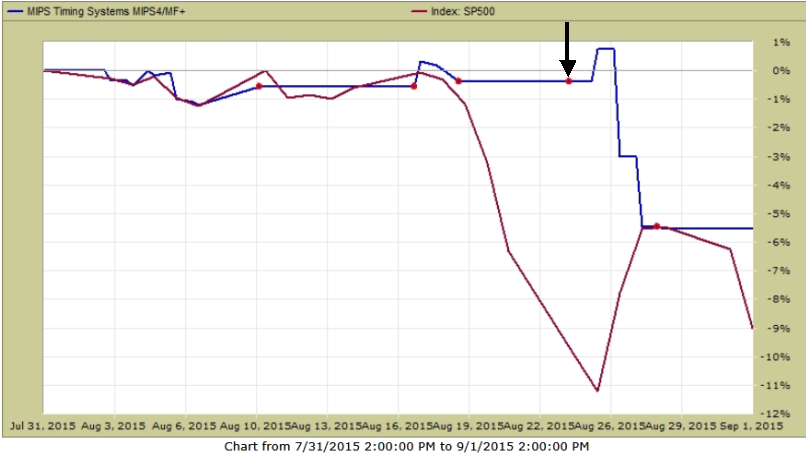
MIPS YTD in 2015
The graph from TimerTrac.com below shows the MIPS4 performance YTD thru August, 2015 (you can see the "one-bad-day" in the graph).
As discussed above and can be seen in the graph below, MIPS was hanging in there until late August, when MIPS was down only 2%, while the SPY was down 9%. Then the one-bad-day came along and upset the cart.
Now, through August 2015, MIPS and the SPY are both down about 7%. So even after all of the hoopla and "bad luck", MIPS has not done any worse than buying and holding the SPY.
MIPS4 YTD in 2015
(Red dots are trade dates)
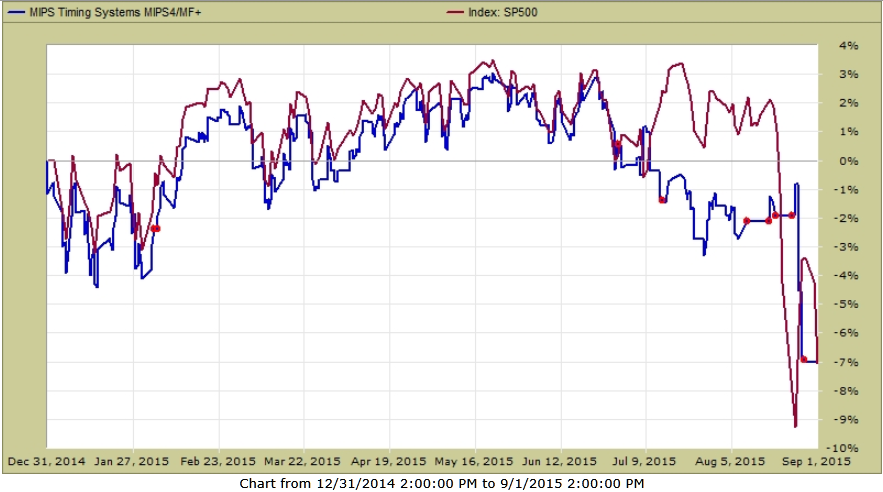
MIPS3 in 2008
Whether this drop is a correction or the beginning of a market crash, we have plenty of time to make money, After backtesting in 1987 and 2003, and observing MIPS live in 2008, we feel 99% sure that MIPS will make us money in down markets. See MIPS3's "actual performance" graph in 2008 as "verified" by TimerTrac.com immediatelybelow:
MIPS3 in 2008
(Red dots are trade dates)
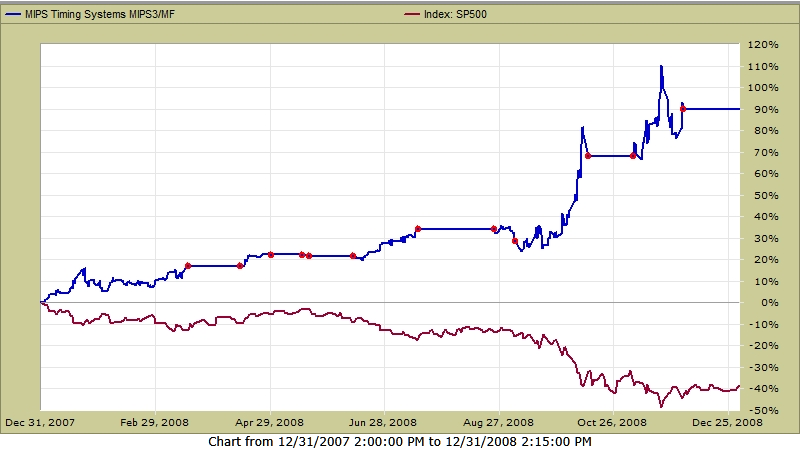
MIPS4's Long-Term Performance (2003-2015 ytd)
o When looked at from a "Long-Term View", the ONE BAD DAY goes away !!!
- So, don't let one-bad-day scare you away...
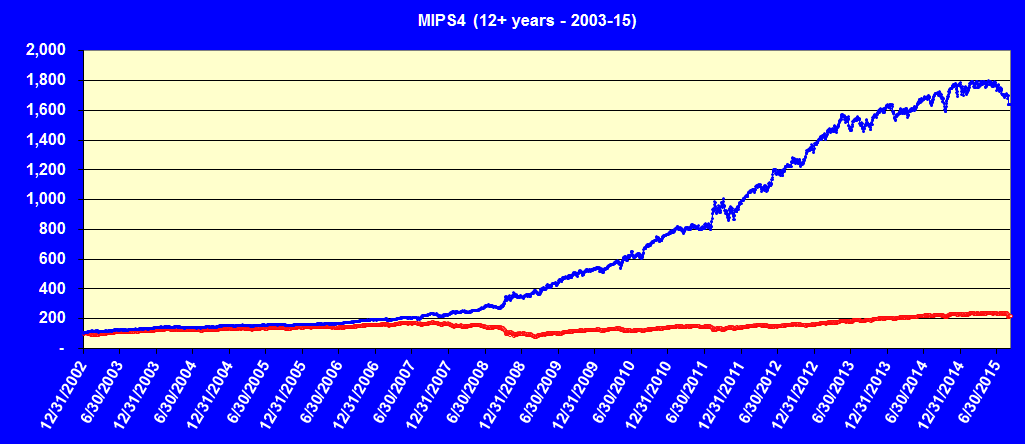
Stay tuned…